
Publisher:
Bonnie King
CONTACT:
Newsroom@Salem-news.com
Advertising:
Adsales@Salem-news.com

~Truth~
~Justice~
~Peace~
TJP
Dec-31-2007 00:02

 TweetFollow @OregonNews
TweetFollow @OregonNews
Freezing Temperatures Bring Black Ice to Roadways
Tim King Salem-News.comSome tips on staying alive while driving this winter. Temperatures at midnight Sunday are in the 20's.
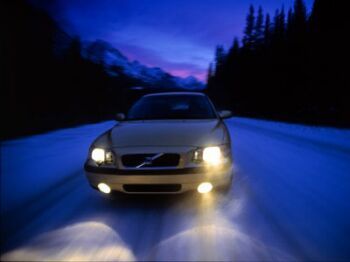 Police and rescue personnel hope drivers slow down and stay alive while driving this winter: they say it starts with slowing down and allowing plenty of time to reach your destination. |
(SALEM, Ore.) - Wet roads in the valley are beginning to turn to black ice as temperatures dip below freezing. Police say it is time for drivers to slow down and pay serious attention to potentially hazardous conditions brought about by winter conditions.
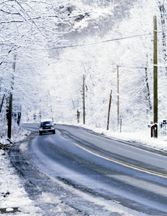 "Drivers are warned to use caution," Lt. Steve Birr with Salem Police said. As the name implies, black ice is invisible. Drivers can't see it, so it is frequently too late by the time the problem is realized.
"Drivers are warned to use caution," Lt. Steve Birr with Salem Police said. As the name implies, black ice is invisible. Drivers can't see it, so it is frequently too late by the time the problem is realized.
Black ice should not be confused with ice that accumulates during snow conditions. Black ice is formed from accumulated moisture, not always direct precipitation. One encounter with black ice will last some people a lifetime. For some it is a lesson, for others it can be a deadly or crippling experience.
In recent days Salem has seen a number of crashes related to ice including one fatality in south Salem involving a local 24-year old woman. See: Salem Resident Dies in Early Morning Ice Related Crash
When a car contacts ice and begins to slide, the driver should steer in the direction their car is sliding. The best idea is to keep speed low enough that your tires never lose their grip on the road. Needless to say, sudden braking and steering can cause a car to slide on a road surface that is covered in ice.
Owners of four-wheel-drive cars and trucks have an advantage when it comes to poor conditions, but police say problems arise from drivers in these vehicles becoming overly confident in the abilities of the four-wheel-drive system. Every vehicle will slide if it is not handled properly over dangerous surfaces. Don't assume that you are above the fray just because your vehicle has off road capability.
In all cases, the first place you will likely encounter ice is on bridges and in shaded areas. Use extreme caution when crossing bridges and also in places the sun can't reach. Ice becomes even more slippery and dangerous when it has melted and refrozen.
Another important thing people should remember is advising others of where you are going and when you should be expected. If a car goes off the road and nobody becomes alarmed, it is likely that the person or people inside could freeze to death. Cell phones don't always receive service, especially in remote mountainous areas. Again, it pays to not be over-confident when it comes to winter driving.
A gentleman I became acquainted with in the course of a news story a couple of years ago is Steve Buckley, longtime Hollywood movie stuntman. He used to crash Dodge Chargers through barriers for the Dukes of Hazard TV show. He teaches advanced driving skills today to police officers, ambulance drivers and firefighters here in Oregon.
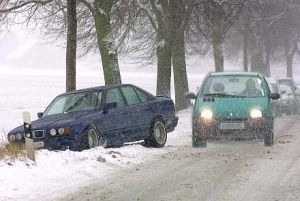 Image courtesy: conti-online.com |
Even Weight Distribution
This applies to high speed driving in particular, but the principle holds true when driving in inclement weather. If you brake too much in a turn then the weight of the vehicle shifts to the front wheels, and your rear tires lose their ability to grip the road. By the same token, accelerating too much places the weight on the rear wheels, taking the grip away from the front which is integral to steering.
Steve says keeping the weight distribution even keeps all four tires firmly planted and greatly increases the chance of you being able to control the car. I have found that by being conscious of the vehicle's weight distribution in normal driving conditions, it also increases the smoothness of the car's motion.
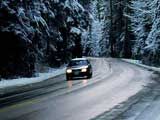 Black ice is probably the biggest hazard drivers deal with this time of year in Oregon, but it certainly isn't the only dangerous driving issue drivers face. Heavy rains have brought significant flooding to Western Oregon in recent weeks. Mudslides have closed other sections of roads and highways. Fog is another danger that motorists deal with throughout the year in the northwest. The only answer to driving safely in reduced visibility is to lower your speed and always use the low beam setting on your headlights.
Black ice is probably the biggest hazard drivers deal with this time of year in Oregon, but it certainly isn't the only dangerous driving issue drivers face. Heavy rains have brought significant flooding to Western Oregon in recent weeks. Mudslides have closed other sections of roads and highways. Fog is another danger that motorists deal with throughout the year in the northwest. The only answer to driving safely in reduced visibility is to lower your speed and always use the low beam setting on your headlights.
Also remember that the chances of another vehicle losing control and entering your lane of travel goes way up in bad conditions like snow and ice. Allow plenty of room, try to pick the least hazardous lane to travel in, and remain extremely guarded toward other drivers who may begin to slide and those who may not see you.
Police and emergency crews hope drivers take it easy and remain very alert and safe while driving this season, and so do we.
When I was first anchoring news at TV10 on the Oregon coast back in 1988, my boss, Roger Robertson of Lincoln City, would close the evening news with this line: "Be safe out there on the highways and byways, remember we'd rather read to you, than about you.
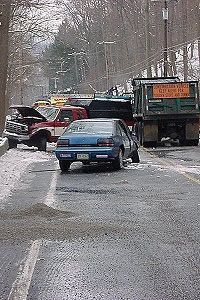 As each year in this business passes, the logic of that slogan of Roger's makes increasing sense.
As each year in this business passes, the logic of that slogan of Roger's makes increasing sense.
--Update: 1:11 AM Monday--
An arctic cold front coupled with rain and snow is causing multiple vehicle crashes on highways and interstates across northwestern Oregon.
The Oregon Department of Transportation reports that all major highways in the northwest section of Oregon have spots of ice, and authorities are reporting dozens of crashes. Affected highways include Interstate 5 between Roseburg and Portland; Oregon 6; Oregon 30; Oregon 26; Oregon 22; Oregon 20; Oregon126; Oregon 58; and Oregon 38.
Oregon Department of Transportation crews will continue applying de-icing chemicals overnight and into Monday morning. Maintenance crews will continue plowing mountain passes overnight, with extra emphasis on Oregon Highway 58 through the Willamette Pass and U.S. Highway 20 through the Santiam Pass.
As emphasized in this article, ODOT Spokesman Adam Torgerson, urges all motorists to use extreme caution while driving.
"Please increase following distances between vehicles, and be prepared to stop in an orderly fashion. Drivers should be especially wary of shaded sections of highway, bridges and overpasses – which tend to ice up first and thaw slowly – for the next 48 hours."
Articles for December 30, 2007 | Articles for December 31, 2007 | Articles for January 1, 2008





Salem-News.com:
Terms of Service | Privacy Policy
All comments and messages are approved by people and self promotional links or unacceptable comments are denied.
Michael S.Mathis December 31, 2007 3:21 am (Pacific time)
I Agree 100% Driving at a reduced speed helps control your car alot more than driving fast! So What if your driving 40 mph on Interstate 5 its better to be safe than Dead.
[Return to Top]©2025 Salem-News.com. All opinions expressed in this article are those of the author and do not necessarily reflect those of Salem-News.com.